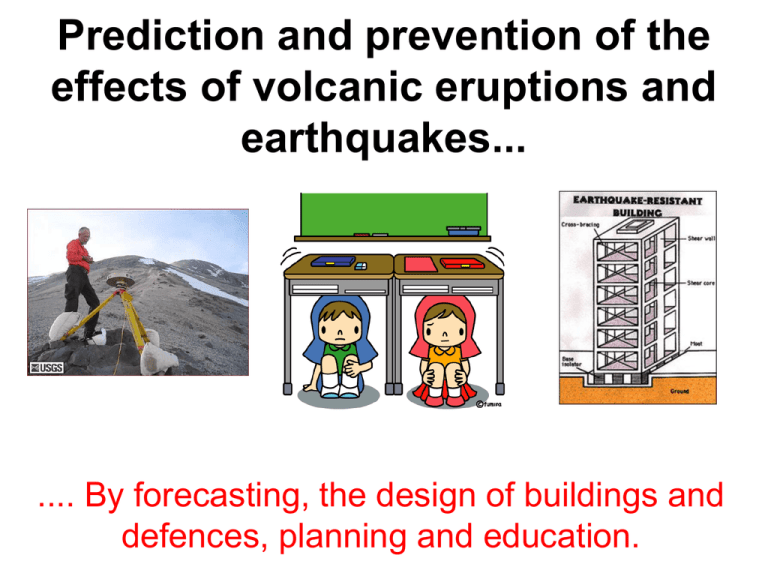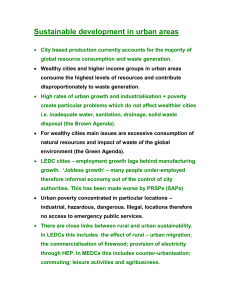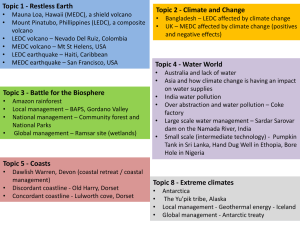Prediction and prevention of the effects of volcanic
advertisement

Prediction and prevention of the effects of volcanic eruptions and earthquakes... .... By forecasting, the design of buildings and defences, planning and education. • http://www.bbc.co.uk/learningzone/clips/pre paring-for-earthquakes/5723.html Disaster Prevention Day JAPAN – 1ST SEPTEMBER This was the moment on September 1, 1923, that the Great Kanto Earthquake struck Tokyo, Yokohama, and surrounding regions. Measuring 7.9 on the Richter scale, the quake not only devastated homes and office buildings but claimed the lives of 140,000 people - many of them being engulfed in the fires that broke out after the tremor. Disaster Prevention Day • On Disaster Prevention Day emergency drills organised by local governments are held throughout the country. • Some of these drills consist of ducking under desks to escape falling objects and evacuating from buildings. At many elementary and middle schools, September 1 is the first day of school after summer vacation. • So a lot of schools carry out an evacuation drill as part of the back-to-school ceremony. Task One 10 minutes • On page 120 there is information about Disaster Prevention Day. • From what you have just heard and the information in the textbook write a short paragraph about the day. Buildings in earthquake zones Which shape of building would be most ‘earthquake proof’? TASK TWO: Draw and explain your answer. Earthquake Proof Buildings 10 minutes Deep foundations into solid rock. Cross bracing to provide extra support to the frame Weights on the roof to counterbalance shaking Several emergency staircases and exits to speed up evacuations Shock absorbers in foundations to absorb seismic waves Roof covering the area immediately outside the building to prevent pedestrians being showered with broken glass. Differences between MEDCs and LEDCs after earthquakes and volcanic eruptions Task Three Factors affecting the damage caused by earthquakes 1. Which factor/s do you think is/are the most important? 2. Which factors are related to the wealth of the country? 3. How can the education of the population affect the amount of damage caused by an earthquake? Size of the earthquake Emergency services Building design and construction Time of day Education Physical landscape MEDC LEDC MEDCs can put emergency plans into action 1. Local authority experts assess the seriousness of the situation and the damage 2. Local citizens are kept informed – they need to be reassured and told what to do next 3. Immediate emergencies must be dealt with first – All casualties should be taken to hospital – Fires must be put out – these are a big problem if gas pipes have been damaged 4. Disrupted public services such as power, water supply and sewage disposal must be restored as soon as possible because there is a risk of disease. MEDCs can put emergency plans into action continued... 5. Communications such as roads, bridges, railways and telephones may have been damaged and mending these is a top priority so that help from outside the area can get in. 6. The efforts of individuals, governments and NGOs (NonGovernmental Organisations) such as OXFAM must be coordinated. 7. Once the situation is clear, and there’s no risk of a further hazard – life can return to normal. LEDCs are NOT so well prepared 1. Many people in LEDC hazard zones haven’t been given information about what to do if there is a hazard. 2. Some LEDCs DON’T prepare plans – the Government has enough problems already. 3. Communications are bad – many people live in shanty towns with no proper access roads and badly built housing which collapses easily causing more injury. Getting back to normal takes longer too in LEDC’s 1. There are few experts available to assess the situation. 2. Without plans there will be delays dealing with fires, deaths, injured people etc. 3. Badly built housing means more damage and allows fires and diseases to spread quickly. 4. Limited communications mean people still don’t know what’s happening – this means there will only be a few emergency services available. Getting back to normal takes longer too continued in LEDC’s… • Water and power supplies are normally poor and mending them is difficult. • Roads and transport are poor to start with, so it’s difficult to bring supplies of food, medicine, clothes, shelter – even if these are available. • Lack of money means they have to rely on foreign aid which takes time to reach them. • Medical facilities are limited so many people die of injuries or disease linked to dirty water supply and poor living conditions. Task Four 15 minutes • Describe and explain how MEDC’s (rich) are better prepared for volcanic eruptions and earthquake activity than LEDC’s (poor). (6 marks) Consider: – – – – Planning Prediction Response Clean up Task Five • Answer the questions on Page 123 of the textbook. • Remember you should write as many points as possible in your answers – always look at the mark given. • DO NOT over complicate your answers – don’t write too much! • Either write the question or answer in full sentences – this will help you when you revise!











